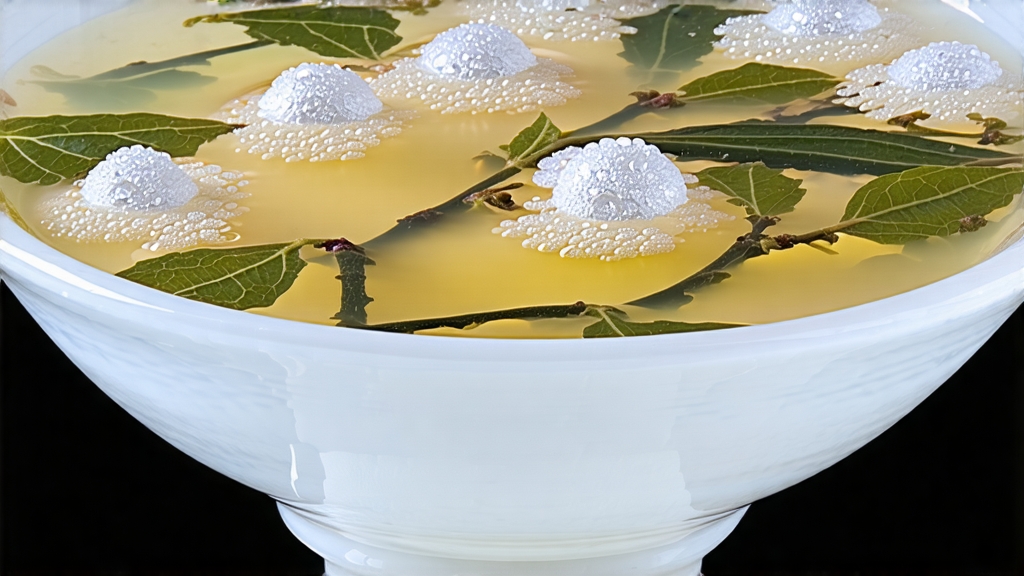
Tucked into the northern corner of China’s Fujian province, the small counties of Fuding and Zhenghe guard a secret that once traveled the Silk Road as softly as starlight: White-Hair Silver Needle (Bai Hao Yin Zhen), the most aristocratic expression of white tea. To international drinkers accustomed to the malty vigor of Assam or the smoky drama of Lapsang, Silver Needle can feel almost too subtle—an olfactory whisper rather than a shout. Yet its history, craft and cup speak with a precision that louder teas seldom achieve. This essay invites you to lean in and listen.
-
A legend written in down
Imperial annals from the Song dynasty (960-1279) already list “white tablets” sent as tribute, but the first unambiguous description of down-covered buds appears in the Ming-era Tea Record of Tian Gong (1597). A century later, traveling merchants discovered that the indigenous Da Bai Hao (“Big White Down”) cultivar produced buds so plump they looked like miniature ivory chopsticks. When lightly withered and dried, the buds kept their silvery cloak intact, giving rise to the name Silver Needle. By the Qing, European diplomats in Canton were paying twice the price of Keemun for these “white needles,” believing the fuzz to be a sign of medicinal potency. -
Terroir where the sea meets the mountains
Fuding’s Taimu mountain range enjoys a maritime monsoon climate: morning fog from the East China Sea meets cool alpine air, creating a 70-80 % relative humidity that slows transpiration and concentrates amino acids. Soils are lateritic granite, acidic (pH 4.5-5.5) and rich in potassium—ideal for the Da Bai Hao and the slightly heartier Da Bai Ye (“Big White Leaf”) clonal lines. Zhenghe, 150 km inland, sits 200 m higher; its greater diurnal range yields buds that are marginally smaller but higher in aromatic terpenes. Together these two micro-zones form the legally protected Geographic Indication for authentic Silver Needle. -
Plucking the impossible inch
Authentic Silver Needle is picked only in early spring for roughly ten days, beginning when the bud reaches 2.5–3 cm but before the first leaf unfurls. Experienced pickers use a “twist-and-lift” motion that keeps the bud intact; any fracture will oxidize into a brown blemish later. A kilo of finished tea requires 30,000 buds, all plucked before ten o’clock when dew is still present—nature’s own refrigeration. Because mechanical harvesters shatter the delicate down, every bud is still gathered by hand, making Silver Needle one of the planet’s most labor-intensive agricultural products. -
The craft of doing almost nothing
White tea’s minimalism is deceptive. Once baskets of buds reach the farmhouse, they are spread on bamboo trays exactly 1.5 cm thick—any deeper and enzymatic heat builds up; any thinner and the buds desiccate too rapidly. For the next 36–48 hours they undergo natural withering under shade cloth that blocks 70 % of sunlight, while louvered windows coax a steady 2 m/s breeze. Moisture drops from 75 % to 12 %, but more crucially the cell walls begin a subtle rupture that frees bound volatiles such as linalool and geraniol. Finally, the buds are given a “soft bake” at 40 °C for twenty minutes, low enough to preserve the enzyme polyphenol oxidase and retain the potential for graceful aging. -
The quiet chemistry of elegance
Silver Needle’s liquor is pale champagne, but its chemistry is vivid. Downy trichomes are 80 % catechin-free polysaccharides that add viscosity without astringency. The bud’s interior, however, brims with methylated catechins (EGCG3”Me) that show anti-allergic activity in vitro. Aged lots develop 2-acetyl-1-pyrroline, the same “popcorn” note found in basmati rice, while thearubigins polymerize into reddish pigments that tint the rim of a decade-old cup. Caffeine averages 3.4 %—higher than many green teas—yet L-theanine at 6 mg/g smooths the ascent, delivering a calm alertness prized by Buddhist